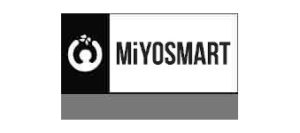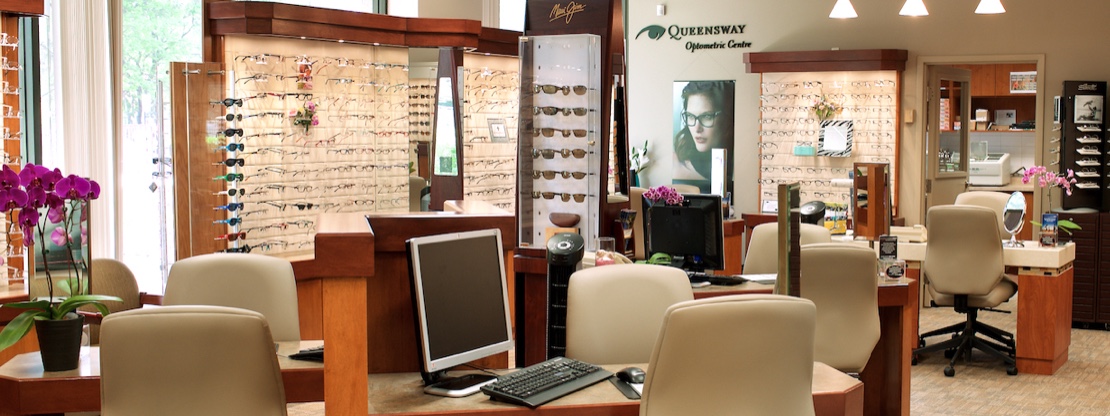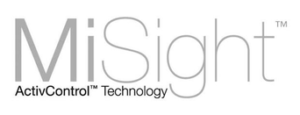- Mississauga, Ontario
- 1.905.848.2020

Myopia Control in Mississauga, ON
Book Online

Helping Your Child Focus on Life in Mississauga
Myopia, also referred to as nearsightedness, is an increasingly common vision problem that affects up to 30% of Canadians. Though there is no cure for myopia, recent studies have suggested that there are ways to control it in children and teens.
Our team at Queensway Optometric Centre in Mississauga has extensive experience with managing myopia. Prolonging a myopia diagnosis may allow the condition to worsen. Help us control this ocular condition before it gets out of hand by scheduling an eye exam for your child.
What Exactly Is Myopia?
Myopia is a refractive error that causes light to land in the wrong place, creating blurry images. Myopia occurs when the cornea is too steep or the eye is too long.
For you to see clearly, light needs to land on the retina, where visual data is sent to your optic nerve, which transmits this data to your brain. Being nearsighted means that your eye bends light into a focal point before the retina, causing distant objects to appear blurry while close-up objects remain clear.
High-Risk Myopia Factors
Genetics plays a role in your child’s chance of developing myopia. Monitoring your child’s vision as they mature is the first step to keeping their sight sharp. Recent studies have shown that external factors like exposure to sunlight can affect a child’s eye development. Constant vigilance and routine children’s eye exams are the best way to spot myopia before it progresses.
Axial Length Measurements with Topcon MYAH
Myopia can affect your children throughout all aspects of their lives, and our team wants to help them enjoy clear, healthy vision.
Topcon MYAH is a game-changer in myopia management that focuses on axial length measurement. Unlike traditional methods focusing on the refractive error, Topcon MYAH takes a deeper look by measuring axial length, the distance from the front to the back of the eyeball.
By tracking changes in axial length over time, MYAH allows us to:
- Proactively identify children at high risk of developing severe myopia
- Objectively monitor the effectiveness of different myopia management therapies
- Develop personalized myopia management approaches based on individual needs
Taking Control of Myopia
While it is true that myopia usually accelerates during the teenage years, it does not necessarily have to get worse as time passes. With an early diagnosis and the employment of some control methods, our eye doctors can help stabilize myopia. At Queensway Optometric Centre, we can evaluate your child’s vision and provide solutions designed to slow down nearsightedness progression.
Multifocal Lenses
We may suggest multifocal contact lenses to control myopia in children. Multifocal contact lenses are specialty lenses that have different prescriptions on different areas of the lens. This allows the lens to correct your child’s nearsightedness while reducing eye strain. Book a contact lens exam to explore this corrective solution further.
Myopia-Slowing Eyeglasses
Wearing eyeglasses with the right lenses can curb the effect myopia has on vision. The optical industry has been developing specialty lenses in recent years that help correct errors associated with nearsightedness. Ask our eyewear experts about lens options that will further protect your child’s vision.

Regular Eye Exams
Myopia can often get worse as a child gets older, so it’s best if spotted early. Especially considering that those with high myopia have also been found to be more predisposed to serious eye problems like early cataracts and even detached retinas.
Early diagnosis allows our eye doctors to build a corrective strategy with your child. Once we know that a patient is nearsighted, it becomes much easier to manage their vision and control their myopia. So make sure your whole family is getting regular annual eye exams.
Atropine Therapy
A common way we can help manage myopia progression is with atropine therapy. Low-dose atropine eye drops have been shown to reduce myopia, and can simply be applied to both eyes at least once a day for a prescribed period of time.
At-Home Tests for Myopia
Children are not always aware they have a vision problem, or they may not be able to articulate if they are. You can help your child by watching for some telltale signs and booking a children’s eye exam with us at Queensway Optometric Centre.
Seeing at School
Ask your child’s school teacher if your young one needs to sit close to the blackboard to see or if they are constantly squinting their eyes during class.
Ease of Everyday Tasks
Pay attention to their habits while they do everyday things. If they squint or complain of headaches while reading or doing homework, they may have a vision problem.
Proactive Checks
Print out an eye chart and do some at-home tests to check your child’s visual acuity.
These tips are not a substitute for a comprehensive children’s eye exam. It is essential you bring your child in for an examination if you think they are displaying increasing signs of nearsightedness. Our optometrists have a deep understanding of myopia and how to control it.
Finding Us Is Easy
Our practice is conveniently located across the street from the Trillium Health Partners Mississauga Hospital.

Our Address
101 Queensway West, Suite 140Mississauga, Ontario L5B 2P7
Contact Information
- Phone: 1.905.848.2020
- Email: [email protected]
Our Hours
2025
- November 15
- November 29
- December 6
- December 20
2026
- January 10
- January 24
- February 7
- February 21
- March 7
- March 21
- April 11
- April 25
- May 9
- May 23
- June 6
- June 20
- July 11
- July 25
- August 15
- August 29
- September 12
- September 26
- October 3
- October 24
- November 7
- November 21
- December 5
- December 19
Our Services
Our Brands





See Our Google Reviews
Our Blog
What Are the Glasses Trends for 2026?
FashionGlassesWhat Are the Glasses Trends for 2026?
FashionGlassesThe glasses trends for 2026 blend bold, expressive shapes with sustainable materials, offering a mix of earthy tones and vibrant colours to suit any personality. […]
The glasses trends for 2026 blend bold, expressive shapes with sustainable materials, offering a mix of earthy tones and vibrant colours to suit any personality. […]
What Are the Best Contacts for Dry Eyes?
Contact LensesDry EyeWhat Are the Best Contacts for Dry Eyes?
Contact LensesDry EyeThe best contacts for dry eyes are the ones selected and fitted for you by an eye care professional after a thorough eye health evaluation. […]
The best contacts for dry eyes are the ones selected and fitted for you by an eye care professional after a thorough eye health evaluation. […]


